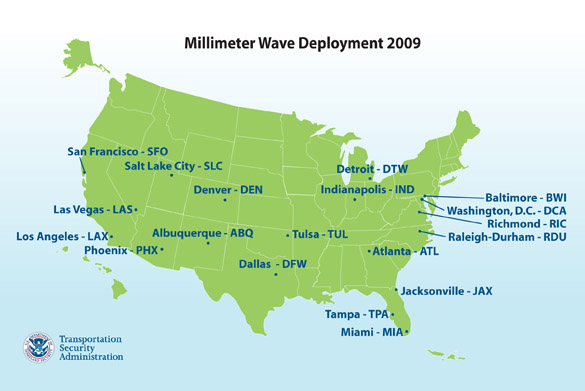Whole Body Imaging
Innovation & Technology
Paperless Boarding Pass | Threat Image Projection | Trace Portals
Whole Body Imaging
- TSA Continues Millimeter Wave Passenger Imaging Technology
- Click here to view millimeter wave being discussed on a CBS 60 Minutes segment.
- Click here to read 'Screeners get closer look' (TulsaWorld.com)

Whole body imaging is an umbrella term used to describe technologies that enable TSA to detect prohibited items including weapons, explosives and other metallic and non-metallic threat items concealed under layers of clothing without physical contact. Whole body imaging technologies are completely voluntary and safe for passengers. To date, nineteen airports across the nation are using this technology.
Whole body imaging is currently being used in primary screening for passengers at six of these nineteen airports. At these six airports, 98-99 percent of passengers have opted to undergo screening by a whole body imaging technology, demonstrating a wide-spread public acceptance of it.
Using whole body imaging technology improves security and reduces the need for pat-down searches for passengers with joint replacements, prosthetics and other medical conditions. It takes a passenger with a joint replacement about 15 seconds to undergo whole body imaging screening as opposed to a 2-4 minute pat down.
With these encouraging results, TSA will continue a public dialogue as we evaluate how well whole body imaging technology works in the airport setting.
TSA is currently using Millimeter Wave, a type of whole body imaging, at 19 airports.

Whole Body Imaging and Privacy
What steps are taken to ensure passengers are protected?
Passenger privacy is ensured through the anonymity of the image. The security officer attending to the passenger never sees the image and the officer viewing the image is remotely located and never sees the passenger. The officers communicate wirelessly via headset to clear the passenger for travel. The image cannot be stored, transmitted or printed, and are deleted immediately once viewed. In fact, the machines have zero storage capability. Additionally, all facial images are blurred.
- Click here to learn more about Millimeter Wave technology.


